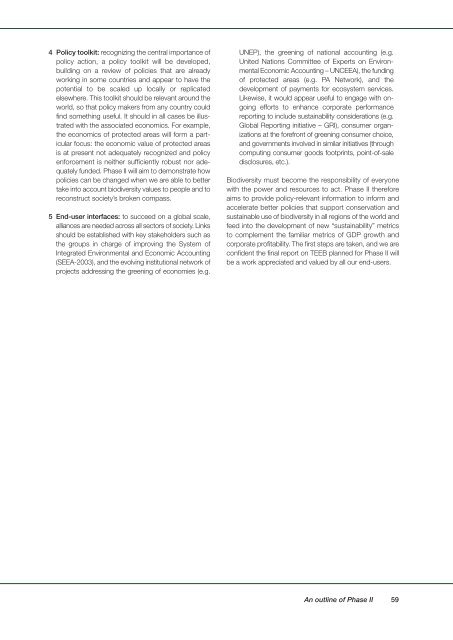Interim Report - TEEB
Interim Report - TEEB
Interim Report - TEEB
Create successful ePaper yourself
Turn your PDF publications into a flip-book with our unique Google optimized e-Paper software.
4 Policy toolkit: recognizing the central importance of<br />
policy action, a policy toolkit will be developed,<br />
building on a review of policies that are already<br />
working in some countries and appear to have the<br />
potential to be scaled up locally or replicated<br />
elsewhere. This toolkit should be relevant around the<br />
world, so that policy makers from any country could<br />
find something useful. It should in all cases be illustrated<br />
with the associated economics. For example,<br />
the economics of protected areas will form a particular<br />
focus: the economic value of protected areas<br />
is at present not adequately recognized and policy<br />
enforcement is neither sufficiently robust nor adequately<br />
funded. Phase II will aim to demonstrate how<br />
policies can be changed when we are able to better<br />
take into account biodiversity values to people and to<br />
reconstruct society’s broken compass.<br />
5 End-user interfaces: to succeed on a global scale,<br />
alliances are needed across all sectors of society. Links<br />
should be established with key stakeholders such as<br />
the groups in charge of improving the System of<br />
Integrated Environmental and Economic Accounting<br />
(SEEA-2003), and the evolving institutional network of<br />
projects addressing the greening of economies (e.g.<br />
UNEP), the greening of national accounting (e.g.<br />
United Nations Committee of Experts on Environmental<br />
Economic Accounting – UNCEEA), the funding<br />
of protected areas (e.g. PA Network), and the<br />
development of payments for ecosystem services.<br />
Likewise, it would appear useful to engage with ongoing<br />
efforts to enhance corporate performance<br />
reporting to include sustainability considerations (e.g.<br />
Global <strong>Report</strong>ing initiative – GRI), consumer organizations<br />
at the forefront of greening consumer choice,<br />
and governments involved in similar initiatives (through<br />
computing consumer goods footprints, point-of-sale<br />
disclosures, etc.).<br />
Biodiversity must become the responsibility of everyone<br />
with the power and resources to act. Phase II therefore<br />
aims to provide policy-relevant information to inform and<br />
accelerate better policies that support conservation and<br />
sustainable use of biodiversity in all regions of the world and<br />
feed into the development of new “sustainability” metrics<br />
to complement the familiar metrics of GDP growth and<br />
corporate profitability. The first steps are taken, and we are<br />
confident the final report on <strong>TEEB</strong> planned for Phase II will<br />
be a work appreciated and valued by all our end-users.<br />
An outline of Phase II<br />
59

















